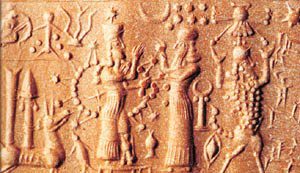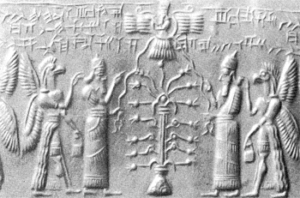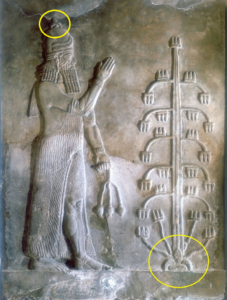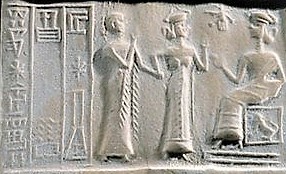Earth’s Ancient HistoryA Website dedicated to Ancient Times
(Texts: All Artifacts, Color Coding, & Writings in Bold Type With Italics Inside Parenthesis, are Added by Editor R. Brown, not the Authors, Translators, or Publishers!)
(gods in blue …mixed-breed demigods in teal…)
 (Inanna with alien technologies, & grandfather Enlil, King Anu’s royal son & heir to throne of planet Nibiru, appointed by King Anu to be his Earth Colony Commander, with many symbols of alien gods above them)
(Inanna with alien technologies, & grandfather Enlil, King Anu’s royal son & heir to throne of planet Nibiru, appointed by King Anu to be his Earth Colony Commander, with many symbols of alien gods above them)
WHEN SHARA (Inanna’s son) SAID TO ENLIL,
AND STOOD AT HIS SERVICE,
GISHAKIDU, THE BELOVED OF SHARA –
HERO AND FIERCE ENCHANTER OF SUMER,
THE BOLD ONE WHO TURNS BACK THE LANDS,
THE CONQUEROR OF NIN-URRA,
 (eagle-headed & winged Apkulla / pilots, son Enki, Sky Father Anu in his sky-disc above the Tree of Life, & Earth Colony Commander son Enlil)
(eagle-headed & winged Apkulla / pilots, son Enki, Sky Father Anu in his sky-disc above the Tree of Life, & Earth Colony Commander son Enlil)
THE MOTHERLY COUNSELLOR OF ENKI,
 (Ninurta, son & heir to Enlil, both born of the “double seed”)
(Ninurta, son & heir to Enlil, both born of the “double seed”)
THE BELOVED COMPANION OF ISHTARAN (Ninurta),
THE MIGHTY FARMER OF ENLIL,
 (king, spouse Inanna, & her mother Ningal; giant semi-divines chosen by Inanna to be her spouses, & then appointed to kingships, acting as the perfect go-betweens for alien gods & primitive “modern earthlings” in each of their cities, as earthlings became educated by them & workers for them)
(king, spouse Inanna, & her mother Ningal; giant semi-divines chosen by Inanna to be her spouses, & then appointed to kingships, acting as the perfect go-betweens for alien gods & primitive “modern earthlings” in each of their cities, as earthlings became educated by them & workers for them)
THE KING CHOSEN BY INANNA;
HE DUG THE CANALS, HE SET UP THE STELES-
Commentary: The cone and the vase relate to the Umma-Lagash border conflict that lasted over the reign of many kings between ca. 2450 and 2300 BC, with many bloody battles. This conflict is the earliest well documented piece of history. All the written and artistic materials came from Lagash, such as the stele of the vultures in The Louvre. The cone and the vase for the first time tell the history from Umma’s point of view. The present MS also reveals the unknown king of the British Museum vase, and dates it to ca. 2385 BC.
In Sumerian on limestone, Umma, Sumer, ca. 2385 BC, 1/3 of a truncated cone, h. 11,9 cm, originally ca. 35 cm, diam. 5,3-7,3 cm, 2 columns, compartments with 30 lines in a transitional linear script between pictographic and cuneiform script.
Context: Continuation of the text (mainly listing the boundaries of Shara of Umma) on British Museum terracotta vase, former Erlenmeyer Collection (Christie’s 13.12.1988:60), and also related to The Louvre AO 19225, a gold beard from a statue which alludes to the existence of King Gishakidu.